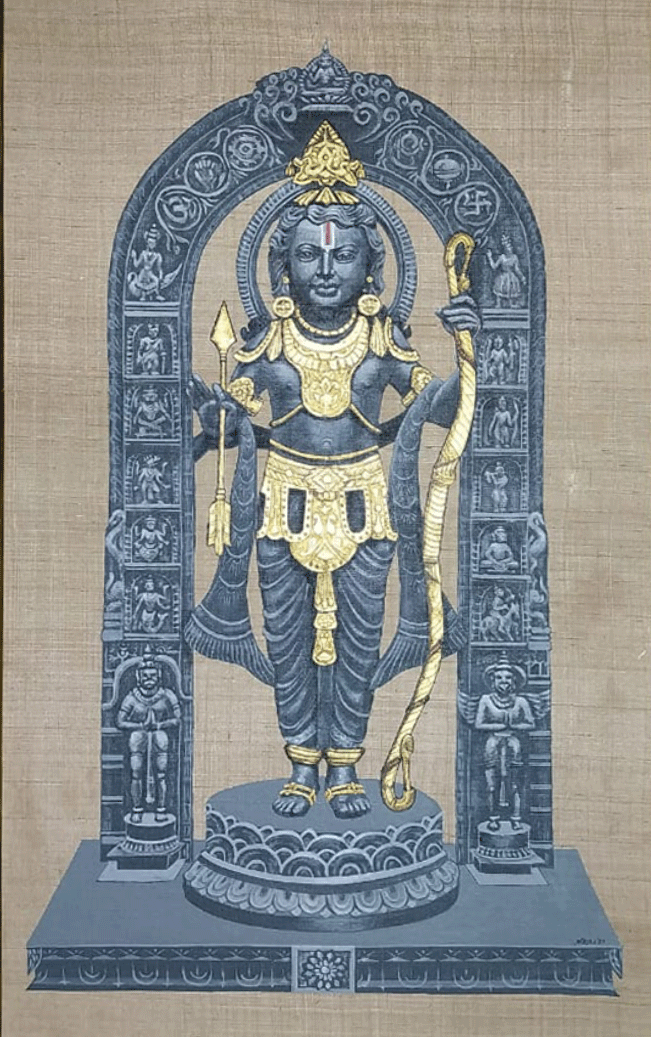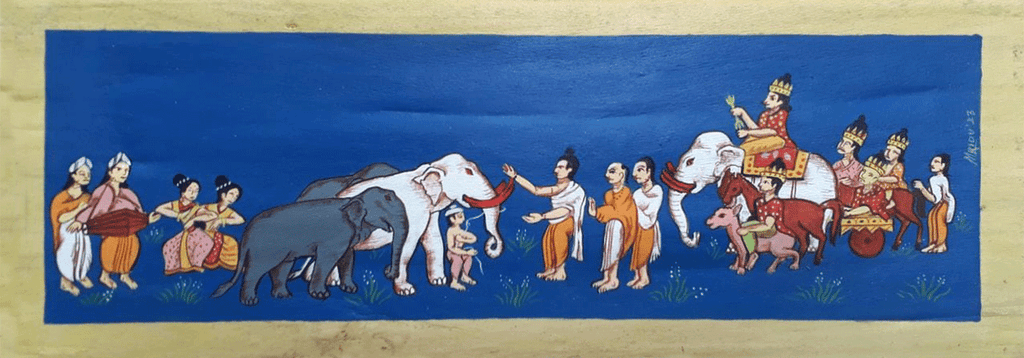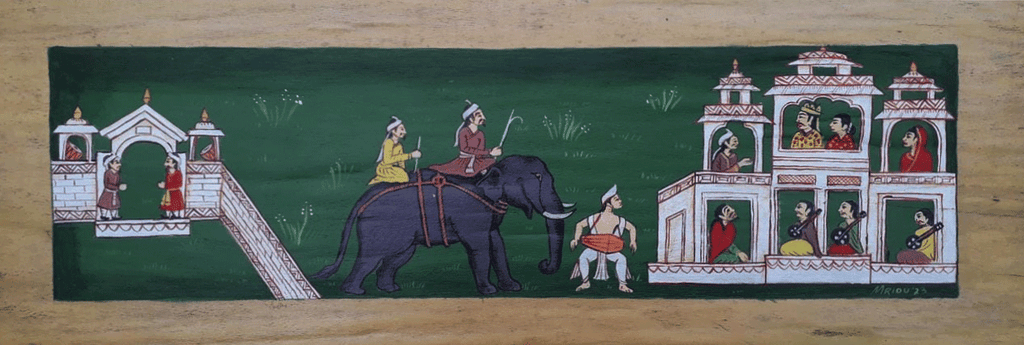Assamese scroll painting is a captivating traditional art form from the culturally rich state of Assam, in northeast India. Rooted in narrative storytelling, these traditional scroll art pieces are celebrated for their intricate illustrations, vivid colors, and spiritual depth. Created on materials like handmade paper, cloth, or bark paper, they seamlessly blend textual and visual elements to convey stories from mythology, religion, and daily Assamese life.
Often used in Ojapali performance art, Ankiya Naat, and Bhaona drama traditions, these scrolls are more than just visual art — they are illustrated devotional dramas. With scenes drawn from the Ramayana, Bhagavata Purana, and local lore, they serve as visual storytelling scrolls and cultural documents that preserve Assamese heritage.
Historical & Religious Significance
The origins of Assamese scroll painting can be traced back to the medieval period, particularly to the Neo-Vaishnavite movement led by Srimanta Sankardev — a saint, poet, and reformer who revolutionized Assamese art and culture. Under his influence, Sattras of Majuli and other monastic institutions in Assam became the creative centers for religious and artistic expression.
Scrolls were integral to Ojapali and Bhaona performances, often functioning as visual aids for spiritual storytelling. These performances combined music, dance, and narrative, with scrolls visually depicting the Krishna Bhakti art tradition. The scrolls also gained prominence during the Ahom dynasty, reflecting the evolving cultural landscape of Assam.
Materials, Techniques & Visual Style
The traditional Assamese scrolls are known for their use of natural pigment painting techniques, drawing color from locally sourced minerals, plants, and charcoal. Artists used indigenous Assamese art materials, such as cloth, bark paper, or palm leaves, as the painting base. These surfaces were coated with natural adhesives to create a smooth texture.
The illustrations often featured flat figurative painting styles, with no use of perspective, and emphasized bold lines and detailed ornamentation. Scrolls typically showcased scenes in a continuous narrative format, a stylistic approach that paralleled other Indian traditions like Pattachitra but remained uniquely Assamese in theme and execution.
Cultural Identity and Regional Variants
This art form flourished in Majuli, home to many Sattras, and in regions like Barpeta, Nalbari, and Sivasagar. Today, Majuli scroll art and Barpeta Satra painting represent regional variations of this genre, each carrying distinctive motifs and narrative styles.
These scrolls are central to Sattriya culture, deeply connected to Vaishnavite art in Assam, and often depict themes from the Puranic texts and Krishna’s life. Their role in Ankiya Naat visual art and Ojapali scroll painting traditions highlights their importance in Assamese narrative traditions and performance-based art forms.
Significance & Revival
As repositories of cultural memory, Assamese scrolls hold immense historical, religious, and artistic value. They serve as educational tools, providing insights into mythology, spiritual practices, and regional folklore. Their preservation is crucial for upholding the cultural identity of Assam, especially as modernity threatens the continuity of such heritage art.
Today, efforts are underway to revive Assamese folk art, with institutions, artists, and platforms like MeMeraki supporting this legacy through documentation, education, and modern adaptations.
Frequently Asked Questions About Assamese Scroll Painting
Can Assamese scrolls be customized or commissioned?
Yes! Assamese scrolls can be customized or commissioned to reflect specific themes, religious stories, or personal artistic preferences. At MeMeraki, artists work closely with patrons to create bespoke scrolls—whether you're looking for a Krishna Bhakti-themed scroll, a Ramayana scroll from Assam, or a contemporary take on monastic art in India.
What stories or themes are typically depicted in Assamese scroll paintings?
These scrolls commonly illustrate narratives from the Bhagavata Purana, Ramayana, and Mahabharata, especially focusing on the life of Lord Krishna and tales from Neo-Vaishnavite teachings. Themes from Ankiya Naat, Ojapali performance art, and historical moments from the Ahom dynasty are also frequently featured.
How are Assamese scroll paintings different from other Indian scroll traditions like Pattachitra?
While both are forms of narrative scroll art, Assamese scrolls are rooted in Vaishnavite culture, particularly that of Srimanta Sankardev and the Sattriya tradition. They often accompany live Bhaona performances and are characterized by their flat figurative style, natural pigments, and integration of text in Assamese script, making them unique from Odisha’s Pattachitra or West Bengal’s Pat art.
What materials are used to create Assamese scroll paintings?
Scrolls are traditionally painted on handmade paper, cloth, or bark paper, often prepared in Sattras of Majuli. Artists use natural dyes made from plants and minerals, fine brushes from bamboo or animal hair, and sometimes apply a protective varnish to preserve the artwork.
Where can I see authentic Assamese scroll paintings?
You can find authentic scrolls in Majuli’s Sattras, Barpeta Satra, and museums like the Assam State Museum and Srimanta Sankardev Kalakshetra in Guwahati. Some pieces are also preserved in academic collections and cultural archives across India.
Are Assamese scroll paintings still being made today?
Yes, although the tradition saw a decline, it is now experiencing a revival. Contemporary artists and cultural initiatives—like those by MeMeraki—are working to preserve and reintroduce Assamese folk art and narrative scroll painting through exhibitions, workshops, and online platforms.
Do Assamese scrolls always contain religious themes?
While most traditional scrolls revolve around religious and mythological stories, especially those from Krishna Bhakti art, there are also scrolls that depict local folklore, historical events, and even aspects of daily rural life in Assam. Modern adaptations may include personalized or secular themes.
What role did Srimanta Sankardev play in the development of this art form?
Srimanta Sankardev, a 15th-century saint and social reformer, was pivotal in shaping Assamese scroll painting. Through his teachings and the establishment of Sattras, he encouraged the fusion of art, music, theatre, and devotion, giving rise to forms like Ankiya Naat, Ojapali, and the visual arts used in these traditions.
What is the connection between Sattriya culture and Assamese scrolls?
Sattriya culture, rooted in the Sattras of Assam, embodies a rich blend of spirituality and artistic expression. Scrolls were essential tools in visual storytelling, accompanying dance-dramas and religious performances. They reflect the aesthetic, spiritual, and narrative traditions central to Assamese monastery painting.



















































